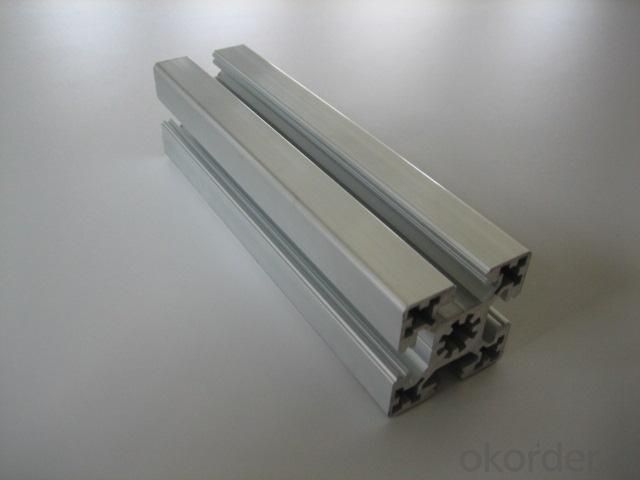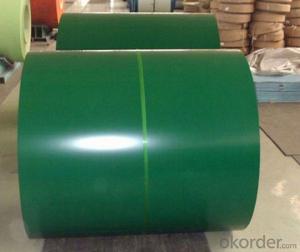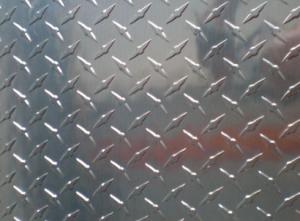1/8" Anodized Industrial T Slot Aluminum Profile Sheets
- Loading Port:
- Shanghai
- Payment Terms:
- TT OR LC
- Min Order Qty:
- 20 m.t.
- Supply Capability:
- 2000 m.t./month
OKorder Service Pledge
OKorder Financial Service
You Might Also Like
1.Structure of Industrial T Slot Aluminum Profile Anodized Description:
Anodizing (also spelled anodising, particularly in the UK and Australia) is an electrolytic passivation process used to increase the thickness of the natural oxide layer on the surface of metal parts. Anodized aluminium surfaces, for example, are harder than aluminium but have low to moderate wear resistance that can be improved with increasing thickness or by applying suitable sealing substances.
2.Main Features of the Industrial T Slot Aluminum Profile Anodized:
High corrosion-resistance;
weather-resistance;
heat-resistance;
alkali-resistance and impact-resistance properties.
3.Industrial T Slot Aluminum Profile Anodized Images:



4.Industrial T Slot Aluminum Profile Anodized Specification:
1. Material: 6063,6061,6060,6005,6005A,etc.
2. Temper: T5 or T6
3. Finish: Mill finish, anodizing, powder coating, electrophoresis, wooden transfer or pvdf/carbon-flouride coated, polishing, brushing, sand blasting
4. Various colors: Silver, bronze, black, gold, blue, grey, champagne, bright, etc.
5. Machining: Cutting, punching, drilling, tapping, milling, bending, welding, CNC etc.
5.FAQ:
① How about your company?
A world class manufacturer & supplier of castings forging in carbon steel and alloy steel,is one of the large-scale professional investment casting production bases in China, consisting of both casting foundry forging and machining factory. Annually more than 8000 tons Precision casting and forging parts are exported to markets in Europe, America and Japan. OEM casting and forging service available according to customer’s requirements.
②How to guarantee the quality of the products?
We have established the international advanced quality management system,every link from raw material to final product we have strict quality test;We resolutely put an end to unqualified products flowing into the market. At the same time, we will provide necessary follow-up service assurance.
- Q: What unique considerations or prerequisites are necessary when installing aluminum sheets?
- <p>When installing aluminum sheets, there are several special requirements to consider. First, ensure that the surface is clean, dry, and free of any debris to guarantee proper adhesion. Use appropriate fasteners designed for aluminum to prevent corrosion. Measure and cut the sheets accurately to fit the intended area, as aluminum can be prone to warping if not handled correctly. Additionally, consider the environmental conditions, such as temperature and humidity, which can affect the installation process. Always follow the manufacturer's guidelines for installation and safety precautions.</p>
- Q: which kind of abraser should be used for deburring of aluminum sheet?
- as for the polishing of aluminum material, we usually nylon wheel and similar products.
- Q: What are the different methods of surface embossing aluminum sheets?
- There are several different methods of surface embossing aluminum sheets, each with its own unique process and outcome. Some of the most commonly used methods include: 1. Mechanical Embossing: This method involves using mechanical tools, such as rollers or presses, to create patterns or designs on the surface of the aluminum sheet. The sheet is passed through the rollers or pressed against a patterned surface, which impresses the design onto the metal. Mechanical embossing is often used for creating repetitive patterns, such as diamond or checkerplate patterns. 2. Chemical Embossing: This technique involves using chemical etching or engraving to create patterns on the aluminum sheet. A chemical solution is applied to the surface of the metal, which selectively etches away the desired areas, leaving behind the embossed pattern. Chemical embossing allows for more intricate and detailed designs to be created on the aluminum sheet. 3. Heat Embossing: Heat embossing is a method that involves using heat to create embossed designs on the aluminum sheet. A heated die or stamp is pressed against the surface of the metal, causing it to deform and create the desired pattern. Heat embossing is commonly used for creating raised logos or text on aluminum sheets. 4. Laser Embossing: Laser embossing utilizes laser technology to create embossed designs on aluminum sheets. A laser beam is directed onto the surface of the metal, vaporizing or melting away the desired areas to create the embossed pattern. Laser embossing offers high precision and allows for the creation of intricate and complex designs. 5. Roll Embossing: Roll embossing is a method where the aluminum sheet is passed through a series of engraved rolls, which impress the desired pattern onto the metal. Each roll has a different pattern or design, allowing for a variety of embossed finishes to be achieved. Roll embossing is commonly used for creating textured or decorative finishes on aluminum sheets. Overall, the different methods of surface embossing aluminum sheets provide a range of options for creating unique and visually appealing designs. The choice of method depends on the desired outcome, complexity of the design, and the specific requirements of the project.
- Q: Are 101 aluminum sheets suitable for marine environments?
- Yes, 101 aluminum sheets are suitable for marine environments. 101 aluminum is a high-strength alloy that is known for its excellent corrosion resistance, making it ideal for use in marine applications. It can withstand the harsh conditions of saltwater, including exposure to salt spray and water immersion, without corroding or deteriorating. Additionally, 101 aluminum has good weldability and formability, allowing it to be easily fabricated into various marine components such as boat hulls, decks, and equipment. Its strength, durability, and resistance to corrosion make 101 aluminum sheets a reliable choice for marine environments.
- Q: What's the standard thickness of aluminum sheet?
- the thickness of tobacco aluminum foil and red wine bottle cap is designed according to customers demands and manufacturer has no stated specification.
- Q: What are the different thickness tolerances for aluminum sheets?
- The thickness tolerances of aluminum sheets can vary based on the grade and application. Normally, the standard tolerances range from +/- 0.006 inches to +/- 0.015 inches. However, it is important to recognize that these tolerances can be stricter or more lenient depending on the specific requirements of the end-use application. For example, in precision-focused industries like aerospace or automotive, tighter tolerances of +/- 0.003 inches might be necessary. Conversely, for less critical applications, looser tolerances of +/- 0.020 inches may be acceptable. To determine the suitable thickness tolerances for a particular aluminum sheet, it is always advisable to consult industry standards or manufacturers' specifications.
- Q: Can aluminum sheets be used for aircraft manufacturing?
- Yes, aluminum sheets are commonly used in aircraft manufacturing due to their lightweight yet strong properties, making them ideal for constructing various components such as wings, fuselage, and structural parts. Aluminum's excellent corrosion resistance and high strength-to-weight ratio make it a preferred choice in the aerospace industry.
- Q: I found a baby dish at a yard sale and all it says on the bottom is Lydney Aluminum PRODUCTS FOR BETTER LIVING. It appears old. Thanks. I already checked google.
- Lydney Aluminum, I don't think that I have heard of them in the boating industry. T.
- Q: What are the safety concerns to be aware of when handling aluminum sheets?
- <p>When working with aluminum sheets, there are a few safety concerns to consider. First, aluminum dust can be a respiratory hazard, so it's important to use proper ventilation and personal protective equipment like masks. Second, sharp edges can cause cuts; always handle aluminum sheets with gloves and proper tools. Additionally, aluminum is a good conductor of electricity, so avoid contact with live electrical wires. Lastly, when cutting or shaping aluminum, eye protection is crucial due to the risk of flying debris. Always follow safety guidelines specific to your workplace and the tools you are using.</p>
- Q: Can aluminum sheet be used for cookware?
- Yes, aluminum sheet can be used for cookware. Aluminum is a popular choice for cookware due to its excellent heat conductivity, which allows for even heat distribution and quick heating. It is lightweight, durable, and resistant to rust and corrosion. Additionally, aluminum cookware is affordable and relatively easy to clean. However, pure aluminum is a soft metal, so it is often combined with other materials, such as stainless steel or nonstick coatings, to enhance its durability and nonstick properties.
Send your message to us
1/8" Anodized Industrial T Slot Aluminum Profile Sheets
- Loading Port:
- Shanghai
- Payment Terms:
- TT OR LC
- Min Order Qty:
- 20 m.t.
- Supply Capability:
- 2000 m.t./month
OKorder Service Pledge
OKorder Financial Service
Similar products
Hot products
Hot Searches
Related keywords




























